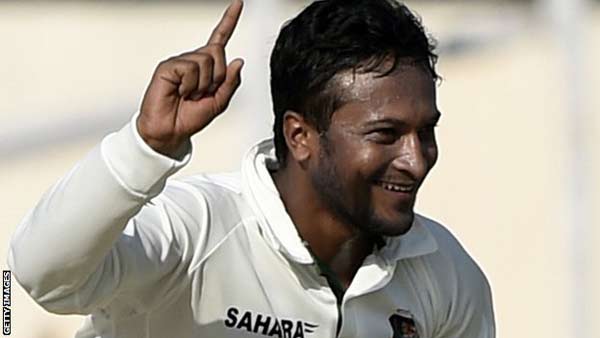
Wellington, New Zealand (BBN)-Shakib Al Hasan. Bangladesh's second-highest run-getter in Tests. And in ODIs and T20Is.
Also Bangladesh's leading wicket-taker in Tests. And in ODIs and T20Is, reports ESPNcricinfo.
Also owner of Bangladesh's top-score in a Test innings, and the second-best figures in Tests.
Also, arguably, the chief culprit in Bangladesh's dire fifth-day collapse in Wellington which led to a stunning defeat after they had posted 595 in their first innings, the highest total ever in a Test defeat.
Shakib is easily the best cricketer Bangladesh have produced; he is also one of their most experienced, having played nearly ten years of international cricket, which makes his acts of rashness - as was seen in Wellington - even more difficult to comprehend.
His unconventional approach is sometimes reminiscent to that of Habibul Bashar, who was Bangladesh's best batsman in the early and mid 2000s despite an extremely unorthodox technique.
While there have been instances when Shakib's approach has confounded critics and puzzled fans, there is no doubting his class and the overall numbers he has racked up in Tests.
For a start, he is one of only five players to score a double-century and take a ten-wicket haul in Tests.
The others are Vinoo Mankad, Allan Border, Wasim Akram, and Ian Botham.
His all-round numbers in Tests stand up to the toughest scrutiny. With the bat, he averages 40.85, which is better than averages of the four great allrounders of the 1980s, and also better than Tony Greig (40.43), Keith Miller (36.97), Shaun Pollock (32.31), Chris Cairns (33.53), and Andrew Flintoff (31.77).
His bowling average of 32.45 is better than those of Garry Sobers (34.03), Flintoff (32.78) and Jacques Kallis (32.65).
The difference between Shakib's batting and bowling averages is 8.39.
Among allrounders who have scored 2000-plus runs and taken 100-plus wickets in Tests, only five players - Sobers, Kallis, Imran Khan, Miller and Pollock have a higher difference. Botham, Kapil, Hadlee, Greig and Chris Cairns all have a smaller difference between their batting and bowling averages.
Shakib's numbers perhaps also mean more because he plays for a relatively weak team, and has usually been the key player with both bat and ball for Bangladesh.
Also, playing for Bangladesh means limited opportunities to play Test cricket: in nearly a decade, Shakib has played only 45 Tests, which is about half the number he would have played had he belonged to one of the bigger teams.
In nearly ten years of international cricket, Shakib hasn't yet played a Test against Australia, which is telling commentary on international scheduling over the last decade.
The limited opportunities, though, haven't prevented him from making an impact with both bat and ball.
With the bat, he averages more than 40 against New Zealand, Pakistan, West Indies and Sri Lanka, including averages of more than 65 against the first two teams mentioned; with the ball, he averages less than 32 against England, New Zealand, South Africa, West Indies and Zimbabwe.
Shakib's value to Bangladesh can be gauged by his per centage contribution with both bat and ball to the team's runs and wickets in the Tests he has played.
As a batsman, he contributes almost 14 per cent of the total runs for Bangladesh (including extras); with the ball, he takes 28 per cent of Bangladesh's wickets in the matches he has played.
Add those percentages up, and his total of 41.99 is next only to Richard Hadlee's 42.51, among allrounders with 2000-plus runs and 100-plus wickets.
Hadlee's batting contribution was relatively meagre, but he was the main weapon for New Zealand's bowling attack, taking 34 per cent of their wickets.
This statistic will admittedly favour the bowling allrounders more than the batting ones, as a bowler's share of the total wickets is higher than a batsman share of total runs (as only four or five bowlers do the bowling compared to six or seven specialist batsmen in a team).
However, this number does indicate Shakib's value to Bangladesh, compared to those of other allrounders to their teams.
Shakib is also one of only four players to have held the record for best bowling figures and highest Test score for a team: till Taijul Islam's 8 for 39 against Zimbabwe in October 2014, Shakib's 7 for 36 against New Zealand in 2008 stood as Bangladesh's best for six years.
And his 217 against New Zealand in the Wellington Test is now Bangladesh's top score in Tests.
The only others to hold this record are Roger Blunt of New Zealand, Amar Singh and Vinoo Mankad. Blunt's 45 and 3 for 17 came in New Zealand's first ever Test, so there was very limited sample size to choose from.
Similarly, Amar Singh's 51 came in India's first Test, while his 7 for 86 came in their fourth.
Mankad's records were more meaningful: his 231 came in India's 49th Test, and his 8 for 52 in their 30th match.
Shakib's records have come much later in Bangladesh's Test journey: his best figures of 7 for 36 came in their 54th Test, and his 217 in their 96th.
Shakib's Test numbers, and a comparison with other allrounders, clearly illustrate just how well his numbers match up with some of the best in the world.
At the same time, those numbers also make his act on the fifth morning in Wellington all the more inexplicable.
BBN/SK/AD